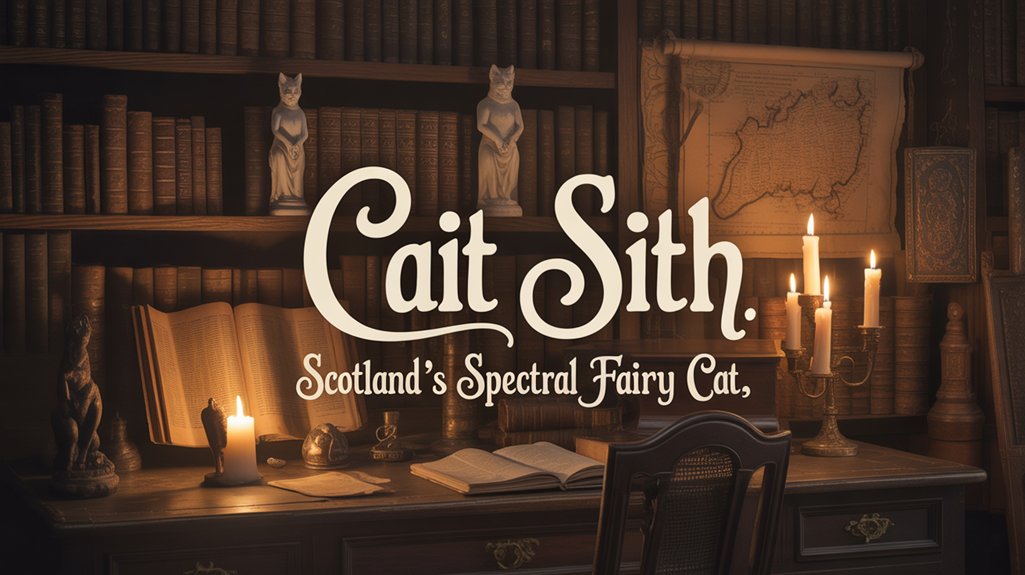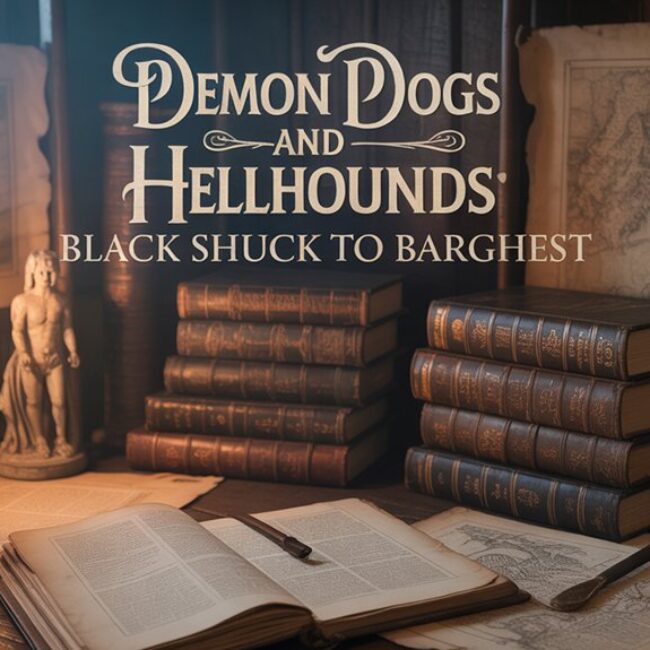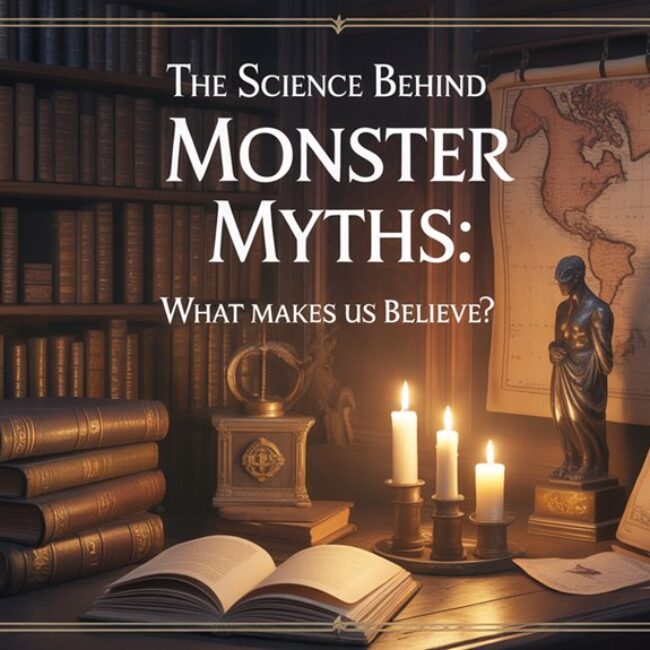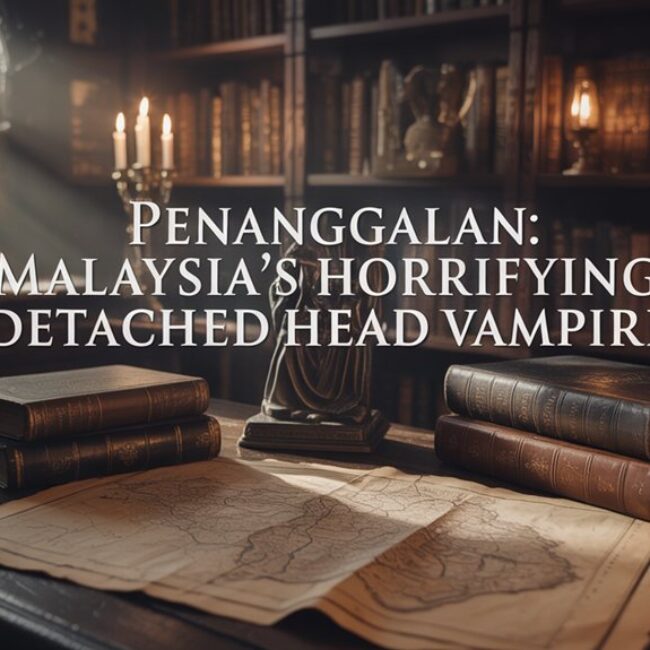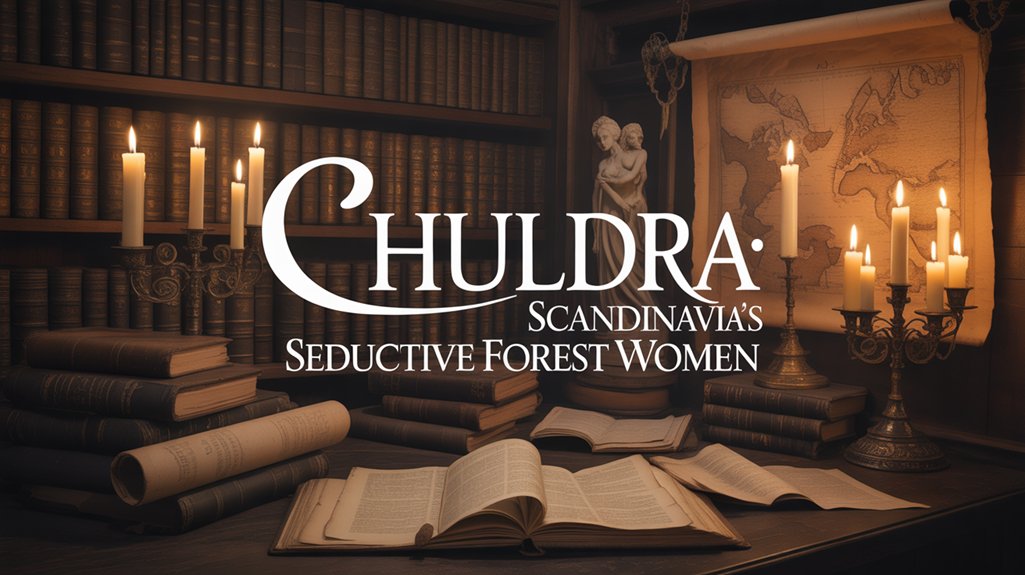
The Cait Sith—pronounced “caught shee”—manifests as a dog-sized feline bearing jet-black fur and a distinctive white chest marking, emerging from pre-Christian Highland consciousness as a psychopomp between mortal existence and the Otherworld. You'll find this chimeric entity possesses human speech, shape-shifting abilities between cat and witch forms, and the eldritch power to steal souls before burial rites conclude, particularly during Samhain when dimensional boundaries blur. Communities countered these depredations through rowan fires, iron scissors at thresholds, and milk offerings to appease this emissary of the Sídhe—protective practices documented throughout Scotland's witch trial era (1590-1662) that reveal deeper cosmological understandings awaiting exploration.
Table of Contents
ToggleKey Takeaways
- Cait Sith is a spectral black cat with a white chest marking from Scottish folklore, capable of human speech and shape-shifting.
- The creature serves as a psychopomp, guarding boundaries between the mortal world and the Otherworld in Celtic mythology.
- Associated with Samhain rituals, Cait Sith steals souls from the deceased before burial rites are completed.
- Highland folklore links Cait Sith to witchcraft, with trial records documenting witches transforming into feline forms.
- Communities used protective measures like rowan wood, iron scissors, and milk offerings to ward off the fairy cat.
Origins and Etymology of the Cait Sith Legend
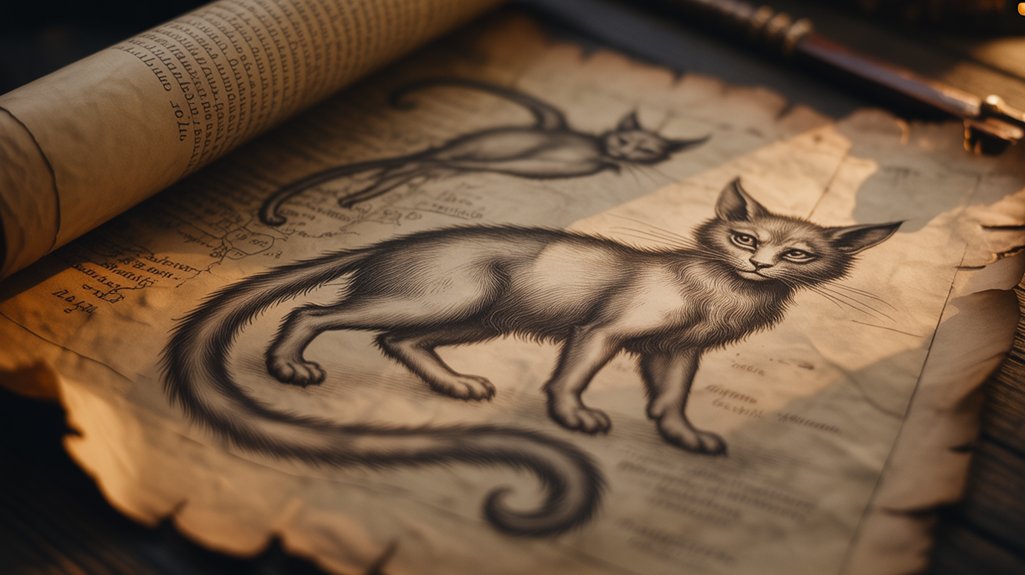
When the Gaelic-speaking peoples of Scotland first whispered the name “Cait Sith”—pronounced roughly as “caught shee” in the tongue's sibilant cadence—they weren't merely describing a household mouser grown large and strange.
The Cait Sith transcended mere feline folklore—it embodied Scotland's liminal threshold between domesticated beast and otherworldly terror.
You're encountering something far more eldritch: a chimeric entity straddling the boundary between beast and otherworld. The etymology itself reveals profound truths about celtic folklore's relationship with liminal beings. Cait” derives from the Old Irish “catt,” while “Sith” designates the fairy folk—those ancient, inscrutable denizens of mounds and twilight domains.
These mythical creatures emerged from pre-Christian Highland consciousness, documented in fragmentary manuscripts dating to the 15th century yet clearly predating their transcription by centuries.
You'll find the Cait Sith inhabiting that uncertain territory where Pictish shamanic traditions merged with later Gaelic mysticism. This wasn't folklore invented to frighten children.
It represented genuine cosmological understanding—a world where animals possessed agency, intelligence, and potentially malevolent intent toward those who'd forsaken ancient pacts.
Physical Characteristics and Supernatural Abilities
The Cait Sith manifests as a creature of unsettling proportions—a feline aberration standing as tall as a full-grown dog, occasionally reaching the size of an ox in certain testimonies preserved through Highland oral tradition.
You'll recognize this chimeric entity by its jet-black coat, interrupted only by a distinctive white chest marking—a spectral brand distinguishing it from mortal cats. The feline features remain unmistakable: pointed ears, luminous eyes reflecting otherworldly intelligence, an arched spine suggesting perpetual readiness to strike.
Its enchanting abilities transcend mere physical presence. You're dealing with a creature that speaks human language, comprehends death's approach, and possesses the eldritch power to steal souls before proper burial rites conclude.
Some accounts document its capacity for shape-shifting, altering between cat and witch forms—a fluidity that reinforces its position as threshold guardian between mortal and fairy domains. The Cait Sith doesn't simply exist; it transgresses boundaries you'd consider inviolable.
The Cait Sith's Role in Scottish and Celtic Mythology
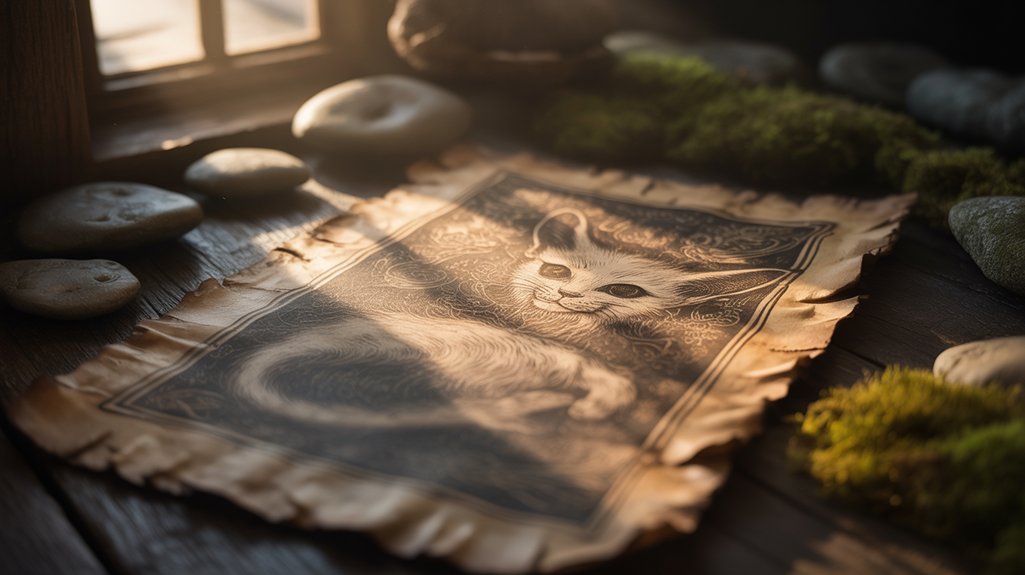
Throughout Highland society, Cait Sith occupied a position of profound ceremonial significance—simultaneously feared as psychopomp and venerated as arbiter between mortal existence and the Otherworld.
You'll discover this eldritch entity woven throughout Celtic folklore as guardian of threshold spaces, where it determined which souls deserved passage beyond mortality's veil. The creature embodied sovereignty itself.
Within Samhain rituals, communities left saucers of milk to appease its chimeric nature, recognizing the Cait Sith as emissary of the Sídhe—those ancient fairy courts dwelling beneath hollow hills.
Milk offerings at Samhain honored the Cait Sith—spectral messenger bridging mortal realm and the Sídhe's subterranean fairy courts.
Unlike mere mythical creatures of entertainment, this spectral feline commanded genuine reverence. Its presence signaled imminent death or otherworldly intervention.
Scottish oral traditions, preserved through generations of seanchaidh storytellers, positioned Cait Sith alongside other liminal guardians—watchers at crossroads between seen and unseen domains.
You're witnessing testimony to humanity's primal need for intermediaries. Beings who negotiate our relationship with mystery itself.
Connections to Witchcraft and Shape-Shifting
Beyond its role as psychopomp, Cait Sith's darker associations emerged through Scotland's persecution-era witch trials, where ecclesiastical courts documented testimonies of *baobh sith*—witches who changed into feline form through pacts with chthonic powers.
These shape shifting folklore accounts proliferated between 1590 and 1662, particularly in Highland districts where pre-Christian beliefs persisted beneath Christian veneer. You'll find trial records describing accused women altering into spectral cats through eldritch rituals, their chimeric forms terrorizing livestock and cursing neighbors.
Witchcraft practices intertwined fluidly with older Celtic traditions: the boundary between fairy cat and changed witch blurred deliberately, purposefully.
Kirk Session records from Aberdeenshire detail confessions of nocturnal gatherings where practitioners assumed feline aspects, their metamorphosis achieved through ointments containing psychotropic herbs—hemlock, belladonna, aconite.
The Cait Sith consequently became both ancient fairy creature and manifestation of transgressive feminine power, a duality that threatened ecclesiastical authority.
Freedom required submission. Or alteration.
Soul-Stealing Powers and Samhain Traditions
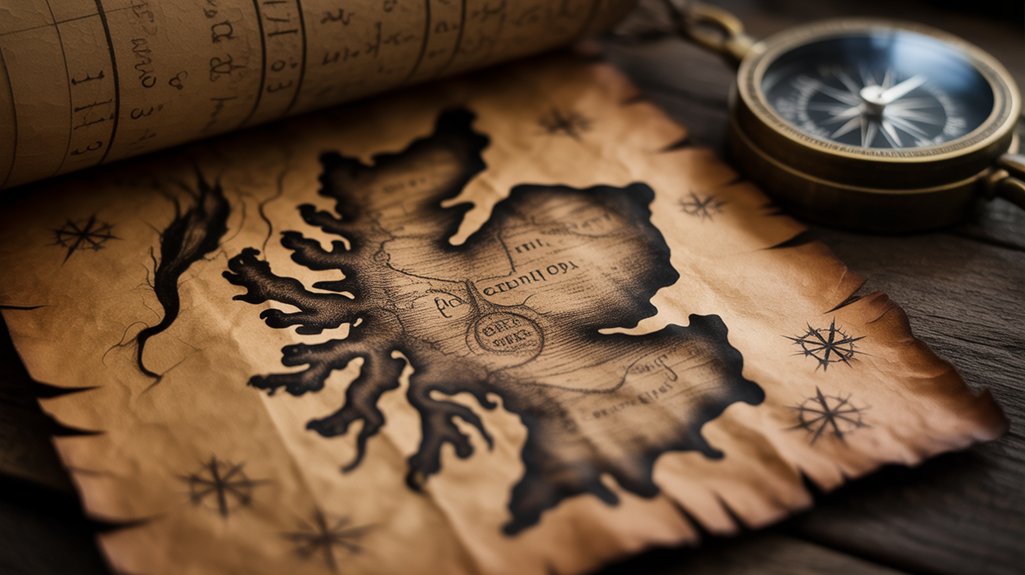
Shape-shifting's transgressive threat paled against Cait Sith's most feared attribute: its capacity to steal souls from the newly deceased before proper burial rites secured their passage. This eldritch predation intensified during Samhain, when the veil between dimensions dissolved into gossamer threads.
Highland communities developed elaborate countermeasures—posting watchers beside corpses, maintaining vigils through October's lengthening nights, employing specific incantations to ward off the chimeric hunter.
The soul harvest represented existential terror. Without proper passage, the deceased wandered eternally between domains.
Samhain rituals evolved specifically to combat Cait Sith's depredations. Families burned rowan wood, whose smoke repelled fairy creatures. They placed iron scissors across thresholds, exploited the cat's aversion to cold metal.
Some communities offered milk and cream outside their doors—appeasement rather than combat, acknowledging powers beyond human control. These practices persisted through centuries, embedding themselves within Celtic death customs, altering November's darkness into contested territory where human determination confronted supernatural hunger. The Cait Sith's malevolent role within Celtic lore reflected broader beliefs about how mythical creatures served as guardians and harbingers at the boundaries between mortal and otherworldly realms.
Modern Cultural Impact and Lasting Legacy
Contemporary popular culture discovered Cait Sith through unexpected channels, modifying Highland folklore into transnational phenomenon.
You'll recognize the spectral feline's most prominent cultural representation in Square Enix's 1997 Final Fantasy VII, where developers altered the eldritch creature into a robotic cat-companion, preserving its name while reimagining its essence. This digital incarnation introduced millions to Scottish mythology's darker corners, sparking renewed interest in authentic folklore traditions.
The cait sith now inhabits gaming universes, fantasy literature, and artistic spaces where ancient beliefs merge with contemporary imagination.
Modern pagans reclaim these chimeric spirits within Neo-Celtic practices, honoring the creature's soul-stealing origins during Samhain observances. You witness this resurgence across Scotland's tourism industry, where Highland tours emphasize supernatural heritage, granting visitors access to stories their ancestors whispered beside peat fires.
The spectral cat's persistence demonstrates folklore's remarkable adaptability—modifying without perishing, evolving without surrendering its liminal power. Freedom-seeking audiences embrace these forgotten narratives, rejecting sanitized myth for authentic shadow-knowledge.
Frequently Asked Questions
How Can I Protect Myself From Encountering a Cait Sith?
You'll need preventative measures rooted in Highland folklore practices: avoid midnight crossroads where this eldritch creature prowls, never accept gifts from white-chested felines, and carry iron—that ancient ward against faerie-kind.
Rowan branches. Salt circles. These ancestral protections still hold power.
The Cait Sith respects those who honor old boundaries, who understand the liminal spaces between worlds.
Don't invoke its name thrice. Don't meet its emerald gaze. Freedom comes through respecting what lurks beyond mortal comprehension.
Are There Any Documented Sightings of the Cait Sith in Modern Times?
What traces remain of this eldritch feline in our disenchanted age?
Recent sightings prove scarce, fragmented whispers rather than verified encounters. The Cait Sith dwells primarily in urban legends now, its chimeric form retreating from modernity's glare.
Folklore collectors occasionally document claims from Highland communities—strange black cats with white chest blazes haunting moonlit crossroads. Yet concrete evidence eludes us.
You'll find the creature exists between domains: neither wholly dismissed nor substantiated, forever liminal, forever free from empirical chains.
What Should I Do if I Think I've Seen a Cait Sith?
If you've witnessed what might be a Cait Sith sighting, document every eldritch detail immediately—the creature's size, the white chest blazon, luminous eyes, circumstances of encounter.
Cait Sith legends emphasize these beings exist between worlds, neither wholly corporeal nor phantasmal. You're free to interpret your experience through whatever lens feels authentic.
Record the location's geography, weather conditions, time of day. Consider consulting local Scottish folklore repositories. Trust your own perception; these chimeric encounters resist conventional explanation.
Can the Cait Sith Be Befriended or Communicate With Humans?
Don't put all your eggs in one basket when seeking Cait Sith communication—these eldritch creatures remain unpredictable.
Scottish folklore records rare instances of befriending Cait Sith through offerings of fresh cream, left untouched at crossroads during liminal hours.
They've occasionally spoken to humans in Gaelic, though their words carry weight beyond mortal comprehension.
You'll find they choose their confidants carefully, drawn to those who respect ancient boundaries between worlds.
Freedom-seekers must approach with reverence, not entitlement.
Are There Similar Cat Spirits in Other Cultures Besides Scottish Folklore?
You'll discover feline spirits haunt mythologies worldwide.
Egypt's sacred temples venerated the Egyptian Mau as divine incarnations of Bastet, goddess of protection and moonlight.
Japan's eldritch Bakeneko shapeshifts between cat and human forms, dwelling in liminal spaces.
While Norse Fenrir represents lupine chaos rather than feline mystery, Native American Pukwudgie legends feature diminutive trickster spirits—sometimes appearing as wildcats—that guard ancient forests.
Each culture's chimeric beings reflect humanity's eternal fascination with cats' otherworldly nature.
Conclusion
You stand now at twilight's threshold, where the Cait Sith prowls—neither wholly beast nor spirit, yet embodying both. This chimeric guardian reminds you that knowledge itself possesses liminal qualities: simultaneously tangible and eldritch, documented yet mysterious. Like the spectral feline haunting Scotland's moorlands, ancient wisdom refuses domestication. You're compelled to honor these traditions not as relics, but as living shadows that still traverse the boundaries between worlds, whispering truths about change's enduring power.

